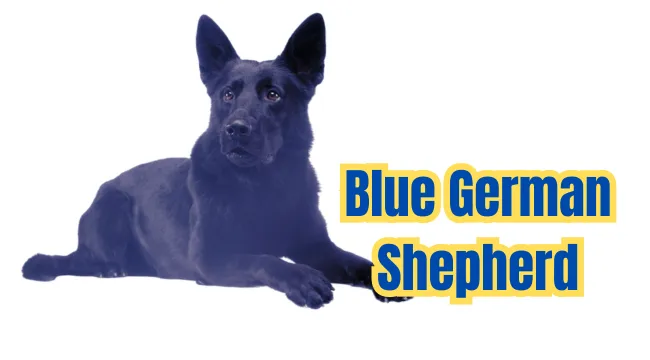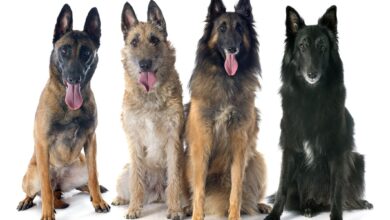
Hey there, fellow dog enthusiasts! Have you ever dreamt of a dog that’s as smart as a German Shepherds but comes in a stunning blue color? Well, dream no more because the Blue German Shepherd is here to steal your heart!
Picture this: a loyal companion with the classic traits of a German Shepherd – intelligence, loyalty, and courage – wrapped up in a coat that shimmers like a clear summer sky. It’s like having your very own canine work of art!
In this article, we’re diving deep into the world of Blue German Shepherds. From uncovering the secrets behind their unique blue coats to exploring their lovable personalities and everything in between, we’ll be your guide on this fascinating journey.
So, grab your favorite treat, curl up with your furry friend (or dream of welcoming one into your life), and get ready to be enchanted by the enchanting world of Blue German Shepherds!
1. Introduction to the Blue German Shepherds
The Blue German Shepherd, also known as the Blue GSD, is a captivating variation of the traditional German Shepherd breed. What sets these dogs apart is their striking blue coat color, which distinguishes them from the standard black and tan or sable colorations commonly associated with German Shepherds. While blue may be the most prominent color, variations such as silver or charcoal hues can also be observed in some individuals.
What Makes the Blue German Shepherds Unique:
The most notable feature of the Blue German Shepherd is, undoubtedly, its distinctive blue coat color. This unique hue is a result of a recessive gene that affects the production of melanin in the dog’s fur, resulting in the blue coloring. Unlike other coat colors, such as black or tan, which are dominant traits in German Shepherds, the blue coloration is relatively rare and sought after by enthusiasts of the breed.
In addition to their striking appearance, Blue German Shepherds share many of the same traits as their traditional counterparts. They are known for their intelligence, loyalty, and versatility, making them highly sought after as working dogs, family pets, and service animals.
Historical Background and Origins:
The origins of the Blue German Shepherd can be traced back to the early 20th century when the German Shepherd breed was first developed in Germany. While the blue coat color has likely existed in the breed’s gene pool for many years, it was not until recently that breeders began selectively breeding for this specific coloration.
The exact timeline of when the Blue German Shepherd emerged as a distinct variation within the breed is somewhat unclear. However, it is believed that the blue coloration gained popularity in the United States during the latter half of the 20th century, as breeders sought to produce dogs with unique and eye-catching appearances.
Today, Blue German Shepherds continue to capture the hearts of dog lovers around the world with their striking beauty and unwavering loyalty..
2. The Mysterious Appeal of the Blue German Shepherds
The Blue German Shepherd holds a mysterious allure that captivates dog enthusiasts worldwide. This unique variation of the traditional German Shepherd breed boasts a distinctive blue coat color that sets it apart from its more common counterparts. The allure of the Blue German Shepherd lies not only in its striking appearance but also in the sense of curiosity and wonder it evokes among admirers.
Exploring the Allure of the Uncommon Blue Coat:
At the heart of the Blue German Shepherd’s appeal lies its uncommon blue coat, which is a result of a recessive gene that influences the production of melanin in the dog’s fur. Unlike the more prevalent black and tan or sable colorations seen in traditional German Shepherds, the blue hue of these dogs is a rarity that adds to their allure.
The blue coat of the German Shepherd is often described as mesmerizing, with shades ranging from deep steel blue to lighter silver or charcoal tones. This unique coloration not only catches the eye but also invites admiration and fascination from those who encounter these majestic dogs.
How Their Unique Look Captivates Hearts:
The unique look of the Blue German Shepherd has a remarkable ability to captivate hearts and leave a lasting impression on anyone who encounters them. Their striking blue coat serves as a conversation starter and a source of admiration, drawing attention wherever they go.
Beyond their physical appearance, Blue German Shepherds possess the same remarkable qualities that define the breed: intelligence, loyalty, and versatility. Whether they are serving as working dogs, loyal companions, or service animals, these remarkable dogs leave an indelible mark on the hearts of those who have the privilege of knowing them.
3. A Closer Look at Their Stunning Appearance
The Blue German Shepherd’s appearance is truly captivating, drawing attention with its unique and striking features. Their overall build mirrors that of the traditional German Shepherd, characterized by a muscular and athletic physique. However, it’s their distinctive blue coat that sets them apart and makes them stand out in a crowd.
The Distinctive Blue Coat: What Sets Them Apart:
What truly distinguishes the Blue German Shepherd is its striking blue coat, which sets it apart from the more common black and tan or sable colorations found in traditional German Shepherds. This unusual coloration is a result of a recessive gene that affects the production of melanin in the dog’s fur, leading to the blue hue.
The shades of blue can vary from a deep steel blue to lighter silver or charcoal tones, adding to the allure and uniqueness of these dogs. Their coat may also exhibit subtle variations in color and shading, creating a mesmerizing and visually appealing appearance.
The Fascinating Genetics Behind Their Eye-Catching Coloration:
The genetics behind the Blue German Shepherd’s eye-catching coloration are a subject of fascination and study among breed enthusiasts and geneticists alike. The blue coat color is the result of a recessive gene known as the dilution gene, which affects the expression of pigment in the dog’s fur.
In simple terms, when a Blue German Shepherd inherits two copies of the dilution gene—one from each parent—it results in the expression of the blue coat color. However, if the dog inherits only one copy of the gene, it may carry the gene but display a more traditional coat coloration.
4. Genetic Mysteries and Controversies of Blue German Shepherds
The genetic basis of the Blue German Shepherd’s unique coat color has long been a subject of fascination and debate within the canine community. While the striking blue hue is undeniably eye-catching, the underlying genetic mechanisms responsible for this trait have remained shrouded in mystery.
Shedding Light on the Genetic Basis of the Blue Coat:
Recent advances in canine genetics have begun to unravel the mysteries surrounding the blue coat color in German Shepherds. Researchers have identified a specific gene, known as the dilution gene, which plays a key role in determining coat coloration. This gene acts to dilute the expression of pigment in the dog’s fur, resulting in the distinctive blue hue observed in Blue German Shepherds.
Through genetic testing and analysis, scientists have been able to map the inheritance patterns of the dilution gene and gain insights into how it influences coat color variation within the breed. By understanding the genetic basis of the blue coat, breeders can make informed decisions to responsibly breed for this trait while minimizing the risk of associated health issues.
Addressing Debates and Controversies Surrounding Blue German Shepherds:
Despite the growing understanding of the genetic basis of the blue coat color, debates and controversies surrounding Blue German Shepherds persist within the canine community. Some critics argue that selective breeding for the blue coat color may compromise the overall health and welfare of the breed, citing concerns about increased susceptibility to certain health issues associated with coat color mutations.
However, proponents of Blue German Shepherds maintain that responsible breeding practices, including health screening and genetic testing, can mitigate these risks and ensure the well-being of the dogs. They argue that the blue coat color is simply a variation within the breed and does not inherently predispose dogs to health problems when bred responsibly.
5. Beyond the Color: Understanding Their Personality

While the blue coat of the Blue German Shepherd may catch the eye, it’s essential to look beyond their appearance to understand their true personality. Blue German Shepherds share many traits with their traditional counterparts, including intelligence, loyalty, and versatility. Understanding these characteristics is key to appreciating the full spectrum of what these remarkable dogs have to offer.
Dispelling Myths and Stereotypes About Blue German Shepherds Temperament:
Despite their exceptional qualities, Blue German Shepherds have sometimes been subject to myths and stereotypes regarding their temperament. One common misconception is that dogs with unusual coat colors may exhibit behavioral issues or temperamental quirks. However, there is no scientific evidence to support this notion.
In reality, Blue German Shepherds are known for their stable and predictable temperaments, much like their traditional counterparts. They are intelligent, alert, and eager to please, making them well-suited for a variety of roles, from loyal family companions to dedicated working dogs.
Highlighting Their Loyalty, Intelligence, and Versatility as Working Dogs:
Blue German Shepherds excel in a wide range of working roles, thanks to their innate loyalty, intelligence, and versatility. Whether serving as search and rescue dogs, police or military K9s, or therapy animals, these dogs demonstrate an unwavering commitment to their tasks and a remarkable ability to adapt to diverse environments and situations.
Their intelligence and trainability make them highly sought after for obedience, agility, and other canine sports, where they consistently shine as top performers. Additionally, their keen sense of loyalty and strong bond with their handlers make them invaluable partners in any working capacity.
6. Health Matters: Caring for Your Blue German Shepherds
Maintaining the health and well-being of your Blue German Shepherd is paramount to ensuring a long and happy life for your beloved companion. While these dogs are generally robust and resilient, it’s essential to be aware of potential health concerns that may be associated with the blue coat color. By understanding these risks and adopting proactive measures, you can help safeguard your dog’s health and vitality.
Identifying Potential Health Concerns Associated with the Blue Coat:
While the blue coat color itself is not inherently linked to specific health problems, some breed enthusiasts and veterinarians have observed a correlation between coat color mutations and certain health issues in dogs. One potential concern is the increased risk of skin problems, such as dermatitis or allergies, which may be more prevalent in dogs with diluted coat colors.
Promoting Responsible Breeding Practices for Healthy Dogs:
Responsible breeding practices play a crucial role in mitigating potential health risks associated with the blue coat color in German Shepherds. Ethical breeders prioritize the health and welfare of their dogs, conducting thorough health screenings and genetic testing to identify and address potential hereditary issues.
When selecting a Blue German Shepherd puppy, it’s essential to choose a reputable breeder who adheres to strict breeding standards and follows best practices for health and welfare. By supporting responsible breeders and advocating for transparency and accountability within the breeding community, we can help ensure the long-term health and vitality of the Blue German Shepherd breed.
7. Training Tips for a Harmonious Bond
Training is not only essential for teaching our Blue German Shepherd basic obedience commands but also for fostering a strong and harmonious bond between you and your canine companion. By utilizing positive reinforcement techniques and capitalizing on their innate intelligence and eagerness to learn, you can create a rewarding training experience for both you and your dog.
Building a Strong Relationship Through Positive Reinforcement Training:
Positive reinforcement training is a highly effective and humane approach to teaching dogs new behaviors and reinforcing desired actions. This training method relies on the use of rewards, such as treats, praise, and play, to encourage your Blue German Shepherd to repeat behaviors you want to see more of.
By consistently rewarding desired behaviors and ignoring or redirecting unwanted behaviors, you can effectively communicate with your dog and strengthen your bond through mutual trust and respect. Positive reinforcement training not only builds a foundation of good behavior but also enhances the relationship between you and your furry friend.
Nurturing Their Natural Intelligence and Eagerness to Learn:
Blue German Shepherds are renowned for their exceptional intelligence and eagerness to learn, making them highly trainable and adaptable companions. To nurture their natural abilities, engage your dog in mentally stimulating activities and training exercises that challenge their problem-solving skills and keep them mentally sharp.
Incorporate a variety of training activities, such as obedience training, agility courses, and interactive games, to keep your Blue German Shepherd engaged and motivated. Remember to keep training sessions fun and rewarding, and always end on a positive note to maintain your dog’s enthusiasm and enjoyment.
By tapping into their natural intelligence and eagerness to learn, you can unlock the full potential of your Blue German Shepherd and cultivate a strong, lifelong bond built on trust, communication, and mutual understanding.
8. Finding Your Perfect Companion-Blue German Shepherds

Finding the perfect Blue German Shepherd companion is an exciting and rewarding journey that requires careful consideration and research. Whether you choose to adopt from a shelter or rescue organization or work with a reputable breeder, it’s essential to assess your lifestyle, preferences, and expectations to ensure a compatible match.
Choosing Between Adoption and Working with Reputable Breeders:
Adopting a Blue German Shepherd from a shelter or rescue organization is a compassionate and fulfilling way to provide a loving home to a dog in need. Many shelters and rescues have Blue German Shepherds available for adoption, offering the opportunity to give a second chance to a deserving dog while also supporting a worthy cause.
Alternatively, working with a reputable breeder allows you to select a Blue German Shepherd puppy with specific characteristics and traits that align with your preferences and lifestyle. Responsible breeders prioritize the health and welfare of their dogs, conducting health screenings and genetic testing to ensure the puppies they produce are healthy and well-socialized.
Signs of Responsible Breeding and Ethical Practices to Look for:
When choosing a breeder, it’s essential to look for signs of responsible breeding and ethical practices. A reputable breeder will be transparent and forthcoming with information about their breeding program, including the health history, lineage, and socialization of their dogs.
Additionally, responsible breeders will provide health certificates and documentation to verify the health status of their puppies’ parents and ensure they have been screened for hereditary health issues. They will also offer support and guidance to new owners, providing resources and assistance throughout the life of the dog.
9. Busting Myths and Misconceptions
As with any unique or uncommon breed variation, Blue German Shepherds are often subject to myths and misconceptions that can cloud public perception. It’s important to separate fact from fiction and provide accurate information to educate potential owners about the realities of owning a Blue German Shepherd.
Separating Fact from Fiction About Blue German Shepherds:
One common myth surrounding Blue German Shepherds is that their blue coat color is indicative of health problems or temperament issues. However, there is no scientific evidence to support this claim. In reality, the blue coat color is simply a variation within the breed and does not inherently affect a dog’s health or behavior.
Another misconception is that Blue German Shepherds are rare or exotic breeds with unique characteristics. While the blue coat color may be less common than traditional colors, Blue German Shepherds share the same temperament, intelligence, and trainability as their counterparts. They are loyal, loving companions with a strong work ethic and an innate desire to please their owners.
Educating Potential Owners About the Realities of Blue Coat Genetics:
Understanding the genetics behind the blue coat color in German Shepherds is key to dispelling myths and misconceptions. The blue coat color is a result of a recessive gene known as the dilution gene, which affects the expression of pigment in the dog’s fur. When two copies of the dilution gene are inherited, it results in the blue coat coloration.
However, it’s important to note that the presence of the dilution gene does not guarantee the expression of the blue coat color in every puppy. Blue German Shepherds may still produce puppies with traditional coat colors if bred with dogs that do not carry the dilution gene. Additionally, responsible breeding practices, including health screening and genetic testing, can help minimize the risk of associated health issues in Blue German Shepherds.
10. Living Life with Your Blue German Shepherd
Once you’ve welcomed a Blue German Shepherd into your home, integrating them into your family and daily routine becomes an exciting and rewarding endeavor. These intelligent and loyal companions thrive on companionship and structure, making them well-suited for life as cherished members of the family.
Integrating Them Into Your Family and Daily Routine:
Integrating a Blue German Shepherd into your family involves creating a welcoming and supportive environment where they feel loved, valued, and included. Establishing routines for feeding, exercise, training, and play helps provide structure and stability, allowing your dog to thrive and feel secure in their new home.
Including your Blue German Shepherd in family activities, such as walks, outings, and bonding sessions, strengthens the bond between you and fosters a sense of belonging. Additionally, providing opportunities for socialization with other dogs and people helps ensure they develop into well-adjusted and confident companions.
Meeting Their Exercise and Mental Stimulation Needs for a Happy, Balanced Life:
Blue German Shepherds are active and energetic dogs that require regular exercise and mental stimulation to maintain a happy and balanced life. Daily walks, runs, or play sessions in a secure, fenced-in area allow them to burn off excess energy and stay physically fit.
In addition to physical exercise, mental stimulation is essential for keeping your Blue German Shepherd’s mind sharp and engaged. Interactive toys, puzzle games, obedience training, and enrichment activities, such as scent work or agility courses, provide mental challenges and prevent boredom.
By meeting their exercise and mental stimulation needs, you can ensure your Blue German Shepherd remains happy, healthy, and well-balanced.
Conclusion
Well, folks, we’ve reached the end of our journey into the world of Blue German Shepherds, and what an adventure it’s been! From learning about their mesmerizing blue coats to discovering their loyal and loving personalities, we’ve uncovered the magic that makes these dogs so special.
As we wrap up, let’s take a moment to celebrate the beauty and uniqueness of Blue German Shepherds. They’re not just dogs – they’re companions, confidants, and cherished members of our families. Their intelligence, loyalty, and unwavering devotion make them more than just pets; they’re true friends who stand by us through thick and thin.
But our journey doesn’t end here. As we bid farewell, let’s carry with us a newfound appreciation for the Blue German Shepherd and a commitment to responsible ownership. Let’s advocate for their well-being, support ethical breeding practices, and spread awareness about these amazing dogs.
So, whether you’re lucky enough to have a Blue German Shepherd by your side or simply dreaming of welcoming one into your life, remember this: their love knows no bounds, and their blue coat is just the beginning of the incredible journey you’ll share together.
Here’s to the Blue German Shepherd – a true gem among dogs, and a shining example of the beauty and wonder that our four-legged friends bring into our lives. Cheers to the amazing adventures yet to come!



